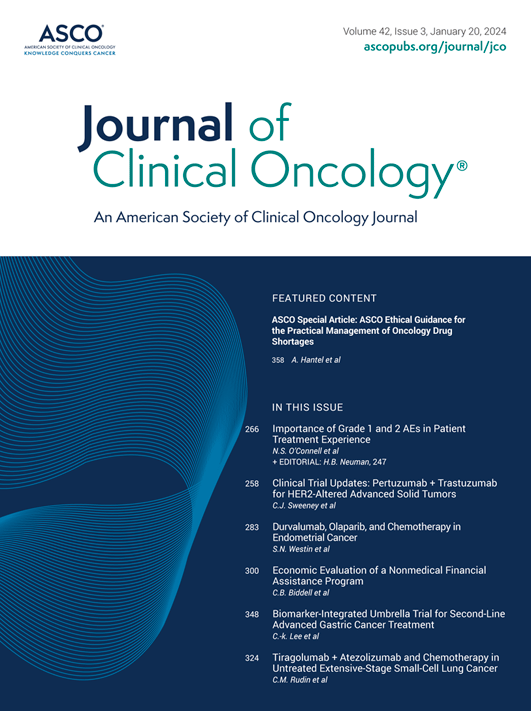RP1联合Nivolumab治疗晚期抗pd -1失败黑色素瘤(IGNYTE)。
IF 42.1
1区 医学
Q1 ONCOLOGY
引用次数: 0
摘要
目的免疫检查点阻断失败后黑色素瘤的有效治疗选择是有限的。RP1 (vusolimogene oderparepvec)是一种基于hsv -1的溶瘤免疫疗法,在这里评估了与纳武单抗联合治疗抗pd -1失败的黑色素瘤。患者和方法患者患有晚期黑色素瘤,经抗pd -1治疗证实进展(≥8周,最后一次治疗前)。RP1瘤内给药(≤8剂,≤10 mL/剂;允许额外剂量)使用nivolumab(≤2年)。客观缓解率(ORR)通过独立的中心评价,使用实体肿瘤反应评价标准1.1版进行评估。结果在140例入组患者中,48.6%为IVM1b/c/d期疾病,65.7%为原发性抗pd -1耐药,56.4%为PD-L1阴性,46.4%既往接受过抗pd -1和抗ctla -4治疗(43.6%联合治疗,2.9%顺序治疗)。确诊ORR (95% CI)为32.9% (25.2% ~ 41.3%;15.0%完全应答)。注射和非注射的反应发生的频率、深度、持续时间和动力学相似,包括内脏病变。中位(95% CI)反应持续时间为33.7个月(14.1个月未达到)。1年和2年的总生存率(95% CI)分别为75.3%(66.9%-81.9%)和63.3%(53.6%-71.5%)。生物标志物分析显示,广泛的免疫激活与反应相关,包括CD8+ t细胞浸润和PD-L1表达的增加。治疗相关不良事件发生率为77.1% 1/2级,9.3% 3级,3.6% 4级,无5级不良事件。结论srp1联合nivolumab在抗pd -1失败的黑色素瘤患者中提供了深度和持久的全身反应,包括那些预后不良的患者。安全性较好,大部分不良事件为1/2级。(由Replimune, Inc.资助;IGNYTE ClinicalTrials.gov, NCT03767348;草案编号:2016-004548-12)。本文章由计算机程序翻译,如有差异,请以英文原文为准。
RP1 Combined With Nivolumab in Advanced Anti-PD-1-Failed Melanoma (IGNYTE).
PURPOSE
Effective treatment options for melanoma after immune checkpoint blockade failure are limited. RP1 (vusolimogene oderparepvec) is an HSV-1-based oncolytic immunotherapy, here evaluated in combination with nivolumab in anti-PD-1-failed melanoma.
PATIENTS AND METHODS
Patients had advanced melanoma that had confirmed progression on anti-PD-1 (≥8 weeks, last prior treatment). RP1 was administered intratumorally (≤8 doses, ≤10 mL/dose; additional doses allowed) with nivolumab (≤2 years). The objective response rate (ORR) was assessed by independent central review using Response Evaluation Criteria in Solid Tumors version 1.1.
RESULTS
Of 140 patients enrolled, 48.6% had stage IVM1b/c/d disease, 65.7% had primary anti-PD-1 resistance, 56.4% were PD-L1 negative, and 46.4% received prior anti-PD-1 and anti-CTLA-4 therapy (43.6% in combination and 2.9% sequentially). Confirmed ORR (95% CI) was 32.9% (25.2%-41.3%; 15.0% complete response). Responses occurred with similar frequency, depth, duration, and kinetics for injected and non-injected, including visceral, lesions. Median (95% CI) duration of response was 33.7 (14.1-not reached) months. Overall survival rates (95% CI) at 1 and 2 years were 75.3% (66.9%-81.9%) and 63.3% (53.6%-71.5%), respectively. Biomarker analysis demonstrated broad immune activation associated with response, including increased CD8+ T-cell infiltration and PD-L1 expression. Treatment-related adverse event rates were 77.1% grade 1/2, 9.3% grade 3, 3.6% grade 4, and no grade 5 events.
CONCLUSIONS
RP1 combined with nivolumab provided deep and durable systemic responses in patients with anti-PD-1-failed melanoma, including those with poor prognostic factors. The safety profile was favorable, with mostly grade 1/2 adverse events. (Funded by Replimune, Inc.; IGNYTE ClinicalTrials.gov, NCT03767348; EudraCT number, 2016-004548-12).
求助全文
通过发布文献求助,成功后即可免费获取论文全文。
去求助
来源期刊

Journal of Clinical Oncology
医学-肿瘤学
CiteScore
41.20
自引率
2.20%
发文量
8215
审稿时长
2 months
期刊介绍:
The Journal of Clinical Oncology serves its readers as the single most credible, authoritative resource for disseminating significant clinical oncology research. In print and in electronic format, JCO strives to publish the highest quality articles dedicated to clinical research. Original Reports remain the focus of JCO, but this scientific communication is enhanced by appropriately selected Editorials, Commentaries, Reviews, and other work that relate to the care of patients with cancer.
 求助内容:
求助内容: 应助结果提醒方式:
应助结果提醒方式:


